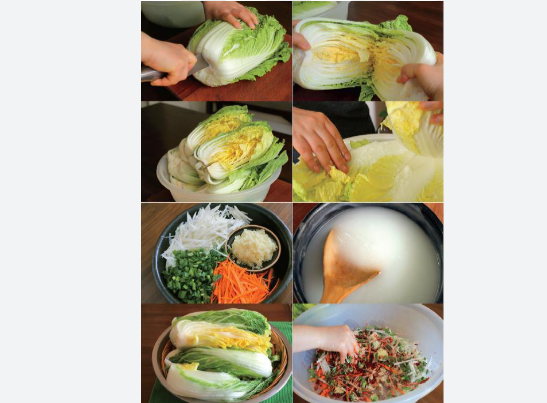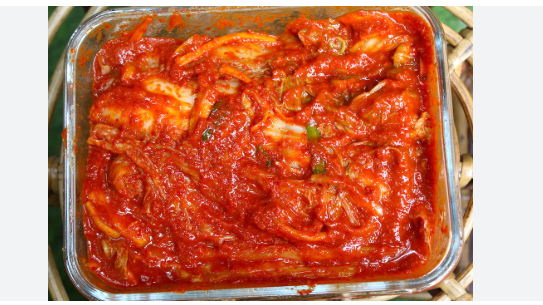Introduction
If you’ve ever enjoyed Korean cuisine, chances are you’ve come across kimchi — the iconic fermented dish that’s spicy, tangy, and full of crunch. Kimchi isn’t just food in Korea; it’s a way of life, a tradition passed down through generations. Making authentic kimchi at home is surprisingly easy, and once you try homemade kimchi, you’ll never want to go back to store-bought versions again.
In this article, we’ll guide you step by step through a traditional kimchi recipe, from preparing the cabbage to fermenting it perfectly. It’s flavorful, packed with probiotics, and adds a spicy kick to any meal.
What is Kimchi?
Kimchi is a traditional Korean fermented dish made with vegetables like napa cabbage or radish, seasoned with chili flakes, garlic, ginger, and fish sauce. The mixture is left to ferment for several days, creating a tangy and spicy flavor that’s loved worldwide.
It’s not just tasty — kimchi is also incredibly healthy. It’s full of vitamins, fiber, and probiotics that support digestion and immunity.
Ingredients You’ll Need
Here’s everything you need for a classic napa cabbage kimchi recipe:

- 1 large napa cabbage
- 1/2 cup salt (for brining)
- 4 cups water
- 1 tablespoon sugar
- 1 tablespoon grated ginger
- 5 cloves garlic (minced)
- 1 small onion (finely chopped)
- 4 tablespoons Korean red chili flakes (gochugaru)
- 3 tablespoons fish sauce (or soy sauce for vegetarian)
- 2 stalks green onions (sliced)
- 1 medium carrot (julienned)
- 1 small daikon radish (optional, julienned)
Step-by-Step: How to Make Kimchi
Step 1: Prepare the Cabbage
Cut the napa cabbage into quarters lengthwise, then chop into bite-sized pieces. Rinse thoroughly. Dissolve salt in water and soak the cabbage for 2 hours, turning every 30 minutes. This draws out moisture and helps soften the leaves.
Step 2: Rinse and Drain

After brining, rinse the cabbage 2–3 times with clean water to remove excess salt. Drain it well and set aside.
Step 3: Make the Kimchi Paste
In a bowl, mix garlic, ginger, onion, sugar, chili flakes, and fish sauce until it forms a thick paste. If you want milder kimchi, reduce the chili flakes slightly.
Step 4: Add Vegetables
Add green onions, carrots, and daikon radish to the paste. Mix them thoroughly so the seasoning coats everything evenly.
Step 5: Combine with Cabbage
Wearing gloves, mix the kimchi paste into the drained cabbage by hand. Gently massage the mixture until every leaf is covered with seasoning.
Step 6: Pack and Store
Transfer the seasoned cabbage into a clean glass jar or airtight container. Press it down firmly to remove air bubbles. Leave about an inch of space at the top for expansion during fermentation.
Step 7: Ferment the Kimchi
Leave the jar at room temperature for 1–2 days to start fermentation. You’ll notice small bubbles and a sour aroma — that’s a good sign! Then, move it to the refrigerator, where it will continue to ferment slowly.
Kimchi tastes best after 5–7 days, but you can eat it anytime depending on your preference for sourness.
Serving Suggestions
Kimchi is incredibly versatile. Here are a few popular ways to enjoy it:
- As a side dish with rice or noodles
- In fried rice for a spicy kick
- In soups and stews, like kimchi jjigae
- With pancakes (kimchi jeon)
- As a topping for ramen or burgers
The possibilities are endless — kimchi adds flavor to almost anything.
Health Benefits of Kimchi
Kimchi isn’t just delicious — it’s also a nutritional powerhouse:
- Rich in probiotics: Supports gut health and digestion.
- High in fiber: Promotes fullness and healthy digestion.
- Packed with vitamins A, B, and C: Boosts immunity.
- Low in calories: Perfect for weight-conscious diets.
- Antioxidant-rich: Fights inflammation naturally.
Eating kimchi regularly can improve your digestive health and give your immune system a natural boost.
Tips for Perfect Kimchi
- Always use Korean chili flakes (gochugaru) for authentic flavor.
- Do not over-salt — rinse cabbage well before mixing.
- Use glass jars, not metal, for fermentation.
- Store in a cool, dark place during fermentation.
- Taste it daily during the first few days to adjust fermentation time.
FAQs About Kimchi
Q1: How long does homemade kimchi last?
Properly stored in the fridge, kimchi can last up to 6 months or longer. It just gets more sour over time.
Q2: Can I make kimchi without fish sauce?
Yes! Substitute soy sauce or miso paste for a vegetarian version.
Q3: Why is my kimchi too salty?
You may not have rinsed the cabbage enough after brining. Try rinsing 2–3 times next time.
Q4: How can I tell if my kimchi has gone bad?
Spoiled kimchi may smell unpleasantly rotten or develop mold. Good kimchi should have a tangy, slightly sour aroma.
Q5: How do I make kimchi less spicy?
Simply reduce the amount of gochugaru or mix in a bit more cabbage or radish to balance the spice.
Conclusion
Making kimchi at home may sound intimidating, but it’s a fun and rewarding process that connects you with Korean culture. The result is a flavorful, probiotic-rich dish that enhances almost any meal. With this easy kimchi recipe, you can adjust the spice level, texture, and flavor exactly how you like it.
Whether you enjoy it fresh or well-fermented, kimchi brings a burst of taste and health to your table. Try it once, and you’ll see why it’s a staple in every Korean household!

